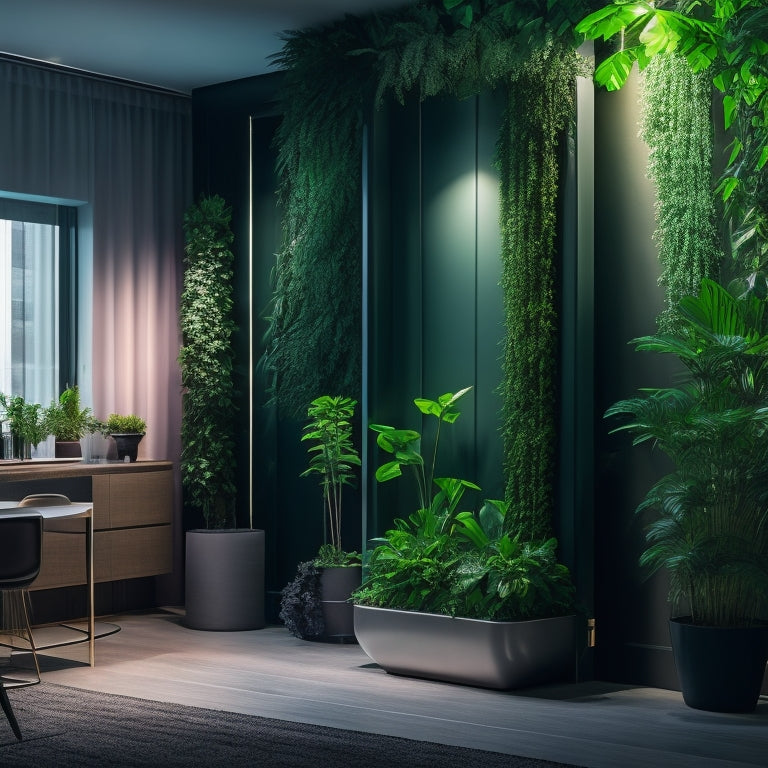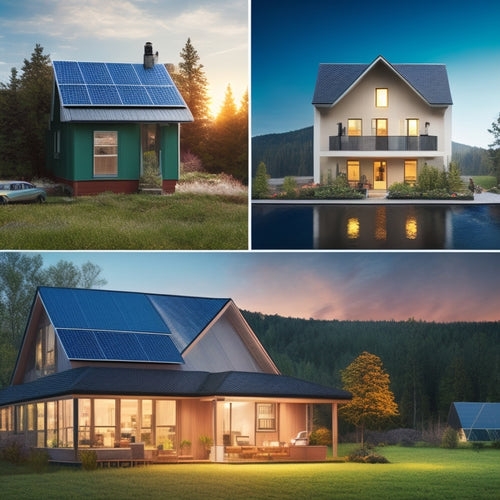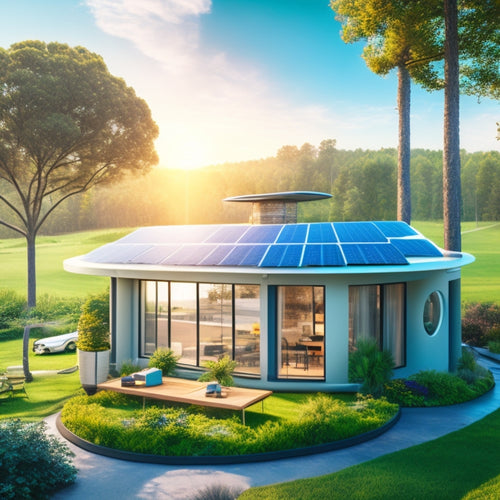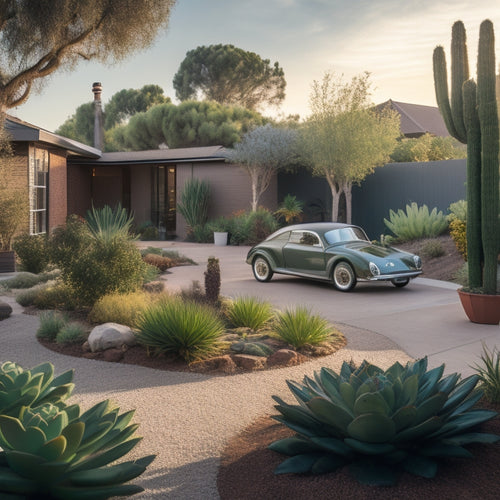
Sustainable Vertical Gardens: Urban Farming Meets Home Innovation
Share
You're embracing the urban farming revolution, where small spaces are converted into thriving gardens that not only provide fresh produce but also contribute to a healthier, more sustainable living environment. By utilizing vertical space, you can optimize your garden's potential, and with careful planning, you can achieve significant food production in even the smallest of areas. From compact arrangements and innovative planters to green walls that improve indoor air quality, you'll uncover the benefits of vertical gardening, including increased crop yields, reduced water consumption, and efficient pest management. As you delve into the world of sustainable vertical gardens, you'll reveal new techniques to enhance your urban farming skills.
Key Takeaways
- Urban farming in small spaces is made possible through container gardening, trellises, and wall-mounted planters that maximize vertical space.
- Green walls improve indoor air quality by removing pollutants, reducing the urban heat island effect, and promoting urban biodiversity.
- Vertical gardening minimizes environmental impact, increases crop yields, and reduces water consumption, making it a sustainable option.
- Innovative gardening techniques like DIY kits, indoor farming, and hydroponic systems enable individuals to grow their own food in limited spaces.
- Smart gardening technology trends, such as energy-efficient solutions and automated watering systems, enhance vertical garden performance and efficiency.
Urban Farming for Small Spaces
In the midst of lively cities, urban farming has become a viable solution for producing fresh produce, even in small spaces. You can adopt container gardening, where plants are grown in pots, planters, or other containers, maximizing vertical space.
Implementing renewable energy solutions like solar panels can also power your urban farm, reducing your carbon footprint.
Edible horticulture is another approach, where you integrate fruit and vegetable plants into your yard's surroundings, creating a visually appealing and productive garden.
With careful planning, you can grow a significant amount of food in a small area, enjoying the freedom to harvest fresh produce right in your backyard.
Consider using trellises, arbors, or wall-mounted planters to make the most of your space.
Green Walls for Better Air
You're likely aware that indoor air quality can be up to five times more polluted than outdoor air, and that traditional HVAC systems can't remove many airborne toxins.
Green walls can help by actively removing pollutants like VOCs, particulate matter, and CO2 from the air, improving indoor air quality and creating a healthier environment.
As electric vehicles reduce greenhouse gas emissions, green walls can also contribute to purifying the urban atmosphere, reducing the urban heat island effect, and mitigating air pollution.
Clean Air Indoors Now
Airborne toxins and pollutants in indoor environments pose a considerable threat to human health, particularly in urban areas where outdoor air quality is often compromised.
You're not alone in this struggle; millions of people worldwide face the same issue. By incorporating green walls into your indoor space, you can greatly improve air quality, much like how widespread EV adoption can enhance driving experience and reduce noise pollution reduced noise pollution.
Additionally, sustainable practices like urban farming can promote a cleaner environment. By doing so, you can:
-
Remove VOCs: Indoor plants absorb volatile organic compounds (VOCs) emitted by furniture, carpets, and paint, reducing their harmful effects on your health.
-
Oxygenate: Green walls release oxygen as a byproduct of photosynthesis, replenishing the air with freshness.
-
Filter pollutants: Leaves and stems act as natural air filters, capturing particulate matter and other pollutants, leaving the air cleaner and healthier to breathe.
Purify Urban Atmosphere
By integrating green walls into urban environments, you can effectively purify the atmosphere, mitigating the impact of pollution on city dwellers. These walls act as natural air filters, removing pollutants and particulate matter from the air, improving overall air quality.
In addition, green walls promote urban biodiversity by providing habitats for local wildlife, further enhancing the ecosystem. The adoption of green energy sources, such as solar-powered EV charging, can also reduce greenhouse gas emissions and air pollution.
Space-Saving Garden Designs
Every square inch counts in urban dwellings, and utilizing vertical space is essential for maximizing garden potential.
You'll need to think creatively to make the most of your available space. Compact plant arrangements and innovative planter solutions are key to achieving a thriving vertical garden.
As we shift to more sustainable living, incorporating renewable energy sources like solar-powered charging solutions can also play a significant role in reducing our carbon footprint.
Consider the following space-saving designs to optimize your garden:
- Tiered planters: Stacked planters that allow for multiple levels of planting, making the most of your wall or corner space.
- Hanging baskets: Suspended planters that add a touch of elegance while keeping your floor and shelves clear.
- Wall-mounted trellises: Training vines or climbing plants to grow upwards, utilizing your walls as a canvas for your greenery.
DIY Vertical Garden Kits
You can create a thriving vertical garden with minimal fuss and expense by opting for DIY vertical garden kits. These kits usually include a trellis or frame, a watering system, and a planter.
When choosing a DIY kit, consider container choices that suit your space and style. For instance, you can opt for planters made from recycled materials or ones with built-in irrigation systems.
Don't forget to investigate soil alternatives, such as coco coir or perlite, which can improve drainage and aeration. Look for kits that cater to your specific needs, whether you're a beginner or an experienced gardener.
With a DIY vertical garden kit, you'll be free to customize and experiment with different plants, arrangements, and designs, giving you the freedom to create a unique and thriving garden.
Indoor Farming Made Easy
Convert your indoor space into a productive oasis with indoor farming made easy.
You'll be growing your favorite herbs and veggies in no time with the right plant selection, gardening tools, and pest management strategies.
Imagine harvesting fresh basil for tonight's dinner or snipping a bouquet of fresh flowers for your living room.
Here are 3 essentials to get you started:
-
Lighting options: LED grow lights or south-facing windows provide the necessary light range for healthy plant growth.
-
Soil health: Use organic potting mixes and compost to create a nutrient-rich environment for your plants.
-
Crop rotation: Rotate your crops seasonally to maintain soil health and prevent pest buildup.
Hydroponic Systems Explained
Taking your indoor farming to the next level, hydroponic systems offer a soilless cultivation method that can enhance yields and reduce water consumption.
You'll be supplying your plants with nutrient-rich solutions rather than relying on soil. This precise control over nutrient intake allows for ideal growth and healthier roots.
Hydroponic systems work by circulating water and nutrient solutions through a network of pipes and tubes, providing your plants with a constant supply of essential elements.
You'll be able to monitor and adjust the pH, temperature, and nutrient levels to create the perfect environment for your crops.
With hydroponic systems, you're in control, and your plants will thrive as a result.
Benefits of Vertical Gardening
Several benefits await those who adopt vertical gardening, a method that maximizes space while minimizing environmental impact. By going vertical, you'll enjoy increased crop yields, reduced water consumption, and a significant decrease in land use.
-
Optimized plant selection: You'll be able to grow a diverse range of plants, from leafy greens to vining vegetables, without worrying about soil quality or availability.
-
Efficient pest management: With plants raised off the ground, you'll reduce the risk of pests and diseases, making it easier to maintain a healthy garden.
-
Increased accessibility: Vertical gardens can be designed to accommodate people with mobility issues, providing equal access to fresh produce and gardening opportunities.
Energy Efficiency in Gardening
When designing your sustainable vertical garden, you'll want to contemplate energy-efficient solutions to minimize your carbon footprint.
You can start by selecting power-saving grow lights that employ LED or OLED technology, which consume considerably less energy than traditional lighting options.
Additionally, incorporating low-energy irrigation systems, such as drip irrigation or misting systems, can help reduce your water and energy usage.
Power-Saving Grow Lights
Your sustainable vertical garden relies on artificial lighting to thrive, and power-saving grow lights are an essential component in energy-efficient gardening.
By incorporating LED technology, you can greatly reduce energy consumption while promoting healthy plant growth. This is achieved through a customized light range that caters to the specific needs of your plants.
Here are three key benefits to evaluate:
-
Cost efficiency: Power-saving grow lights minimize your energy expenses, allowing you to allocate more resources to other aspects of your sustainable garden.
-
Environmental impact: By reducing your energy consumption, you're contributing to a smaller carbon footprint and a more environmentally friendly indoor lighting setup.
-
Harvest optimization: With the right light duration and range, you can optimize your plant growth, leading to a more bountiful harvest and a greater sense of freedom in your sustainable practices.
Low-Energy Irrigation Systems
Optimizing your sustainable vertical garden's water usage is just as essential as its lighting setup.
You'll want to implement a low-energy irrigation system that efficiently delivers water directly to the roots of your plants, reducing evaporation and runoff. Consider installing a drip irrigation system, which can save up to 50% of water usage compared to traditional sprinkler systems.
Additionally, incorporate rainwater harvesting into your setup to collect and store rainwater for non-potable uses like irrigation. This closed-loop system not only conserves water but also reduces your reliance on municipal water supplies, giving you more control over your garden's sustainability.
Smart Gardening Technology Trends
Frequently, innovators in the vertical gardening space are leveraging advanced smart gardening technologies to change the manner in which we grow and maintain plants.
As you investigate the world of smart gardening, you'll find state-of-the-art tools designed to enhance your vertical garden's performance.
For instance:
-
Smart sensors continuously monitor soil moisture, temperature, and light levels, ensuring ideal conditions for your crops.
-
Automated watering systems deliver precise amounts of water and nutrients, reducing waste and minimizing your environmental footprint.
-
Gardening apps allow you to track growth, identify plants, and receive alerts for pest management and nutrient delivery, giving you complete control over your vertical garden.
Vertical Garden Maintenance Tips
Proper maintenance is essential to the long-term health and productivity of your vertical garden. You'll need to monitor soil health by checking moisture levels, pH, and nutrient availability.
Regularly test your soil to identify any imbalances and adjust your fertilization schedule accordingly. For pest management, inspect your plants regularly for signs of infestation, such as whiteflies, spider mites, or mealybugs.
Use organic pest control methods whenever possible, like neem oil or insecticidal soap. Prune your plants to maintain air circulation, promote healthy growth, and encourage fruiting.
Frequently Asked Questions
Can I Grow Root Vegetables in a Vertical Garden?
You can grow certain root vegetable varieties in vertical garden systems, but you'll need to choose compact, shallow-rooted types like radishes or beets, and guarantee your system provides sufficient depth and soil volume for healthy root development.
How Often Should I Water My Indoor Vertical Garden?
You'll need to water your indoor vertical garden when the top 1-2 inches of soil feel dry, usually every 2-3 days, depending on humidity levels; monitor the moisture levels and adjust watering frequency to guarantee ideal growth and prevent waterlogged soil.
Are Vertical Gardens Suitable for Apartments With Low Ceilings?
You're wondering if vertical gardens suit apartments with low ceilings? Yes, they do! By optimizing space and considering light requirements, you can design a compact system that thrives in tight spaces, giving you the freedom to grow your own food anywhere.
Can I Use a Vertical Garden to Grow Medicinal Herbs?
You can cultivate medicinal herbs in a vertical garden, but you'll need to select herbs with similar lighting requirements, such as chamomile and lemon balm, which thrive in partial shade, or plunge your setup to accommodate diverse herb selection.
Do Vertical Gardens Require More Maintenance Than Traditional Gardens?
Don't you think a garden that's literally stacked on top of itself would be high-maintenance? You're right, vertical gardens do require more upkeep, but with strategic plant selection, you'll overcome maintenance challenges and enjoy a thriving, space-saving oasis.
Related Posts
-

What Does Your Home Energy Audit Report Reveal?
Your home energy audit report reveals a detailed analysis of your energy consumption patterns, highlighting areas of ...
-

Gamify Your Home's Energy Generation and Savings
You're taking the next step in optimizing your home's energy generation and savings by utilizing the power of gamific...
-

What Water-Saving Gardens Complement Electric Vehicle Ownership?
As you pair your electric vehicle with a water-saving garden, you're not only reducing your carbon footprint but also...


